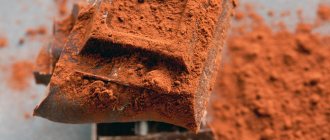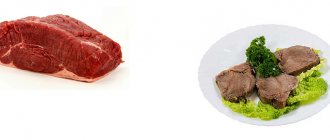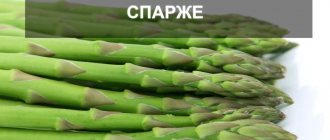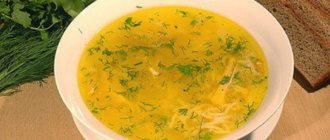- July 26, 2018
- Diets
- Olga Zotova
Today, rice has firmly established itself in the diet of most people, and these are not only residents of the East. Western countries, appreciating the taste, low calorie content and the ability to prepare many original dishes, fell in love with this cereal. Regularly eating cereal, many wonder about the presence of useful microelements, vitamins and calorie content of rice per 100 grams.
Types of rice

Humanity has been cultivating rice for thousands of years. In East Asia, the crop was domesticated 9,000 years ago. During this time, about 8,000 varieties were bred. The classification of rice according to the processing method is the most popular; according to it, they distinguish between cereals susceptible to:
- peeling;
- grinding;
- exposure to steam.
Main types of cereals:
- Brown (brown) is rice that has only been husked. Due to this processing, it preserves the bran shell, which means that all the beneficial substances and minerals contained in the grain will enter the body. Thanks to these properties, it is loved by adherents of a healthy lifestyle.
- Polished rice is rice obtained by removing the hull by grinding. It is most popular among people due to its low price and ease of preparation.
- Parboiled rice is rice that has first been treated with steam, due to which all the beneficial substances contained in the shell are transferred into the grain, and then it is polished.
The most common type of rice consumed by people is white. It cooks quickly, but in terms of beneficial properties it is slightly inferior to steamed or brown.
Wild rice is the healthiest. It contains the most microelements, but it also takes longer to prepare compared to others. Black rice, as it is also called, is a healthy and low-calorie product, perfect for a diet or healthy menu. The calorie content of boiled rice per 100 grams is 100-105 kcal. Before cooking it is soaked for 2-3 hours. Often wild rice is mixed with brown or white - this makes the dish not only beautiful, but also healthy.
Proportions
It is generally believed that you need twice as much water to cook rice. But this is an approximate proportion. It is better to measure the amount of water based on the type of rice:
- for long grain - 1: 1.5–2;
- for medium grain - 1: 2–2.5;
- for round grain - 1: 2.5–3;
- for steamed - 1: 2;
- for brown - 1: 2.5–3;
- for wild - 1: 3.5.
Be sure to read the instructions on the package. The manufacturer knows exactly what kind of processing the rice has undergone and suggests the optimal amount of water for it.
Measure rice and water with a measuring cup - it’s much more convenient. A standard serving for one is 65 ml of dry rice.
Beneficial features
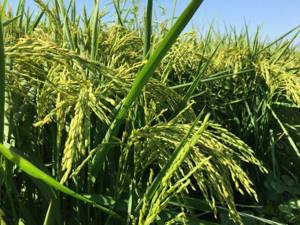
Rice is a storehouse of useful vitamins and microelements that are required for the body to function properly. Moreover, any type of cereal has a positive effect on it. Brown rice is rich in micronutrients and fiber, which make it healthy as it cleanses the body of accumulated toxins. Possessing a rich vitamin and mineral composition, as well as low calorie content compared to white, it has become in demand among people who watch their diet.
Due to the presence of complex carbohydrates, it perfectly saturates and fills with energy, preventing you from overeating. The high content of vitamins B and PP help relieve mental and physical stress. The cereal contains sufficient amounts of calcium, sodium, phosphorus, magnesium, iron, selenium, copper and potassium, which is recommended for people with cardiovascular diseases.
Please note: rice does not contain gluten, so it is recommended for allergy sufferers.
Rice's help in the fight for slimness
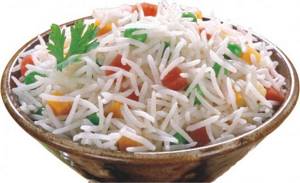
Rice is an excellent absorbent. Many people practice grain-based diets, use cleansing techniques, and use decoction to cope with indigestion.
Nutritionists and adherents of a healthy diet advise adding grain to the menu, as it will help get rid of extra pounds. However, the glycemic index (GI) of rice is high, so it stimulates the appetite, which means you shouldn’t eat it in unlimited quantities.
Unfortunately, this cereal cannot be called an absolutely dietary product, although those who have tried the rice diet report positive dynamics in weight change. After all, 100 grams of boiled rice contains less than 140 kcal.
For a low-calorie or diet menu, wild rice is best. Due to the presence of complex carbohydrates in the shell, it saturates for a long time and prevents the formation of new fat accumulations. Cooked in water without salt or sugar, it will be an excellent dietary dish, on which you can have a fasting day 1-2 times a week, but no more than 4 times. Otherwise, the body will experience severe stress.
How many grams of rice (dry, boiled) in a tablespoon?
To start measuring the weight of rice in grams using spoons, you need to find out how much one tablespoon and one teaspoon weighs. The weight of dry rice and cooked rice will be very different. Therefore, for your convenience, we measured rice in two states, dry and freshly cooked.
| Type of spoon | Dry rice weight | Boiled rice weight |
| In a heaped tablespoon | 20 grams | 30 grams |
| In a level tablespoon | 15 grams | 17 grams |
| In a heaped teaspoon | 8 grams | 14 grams |
| In a level teaspoon | 6 grams | 9 grams |
One teaspoon holds 8 g of rice (with a slide). Without a slide, it holds 6 g of rice.
One tablespoon holds 15 g of rice (without a slide). A heap holds 20 g of rice.
Attention! When measuring the weight of boiled rice with spoons, keep in mind that cooked rice may stick together. For an accurate calculation, use a spoon with a small hill (tubercle or mound).
Contraindications to eating rice
The low calorie content of rice per 100 grams does not mean that it should be consumed in unlimited quantities. Cereals are rich in valuable microelements and vitamins, but they also have contraindications:
- Excessive consumption is not recommended for people prone to constipation. Croup can aggravate the condition.
- An excess of phytic acid contained in the bran shell negatively affects the absorption of calcium and iron.
Eating rice in reasonable quantities will bring undoubted benefits, the main thing is to know when to stop.
Features of the rice diet

If you decide to try rice-based nutrition, you will have to make a lot of effort to endure: tune in emotionally and be patient.
To achieve a visible effect, you need to stay on a diet for 14 days, with the main part of the menu consisting of rice. It is also recommended to add a lot of vegetables and fruits to the diet, small amounts of chicken breast and fish, low-fat kefir and cottage cheese.
The main rule is to cook the cereal in water without salt and sugar, then the calorie content in 100 grams of rice will be the lowest.
Thin or faceted?
The measure of the weight of the product in a glass will directly depend on the glassware that is used. A thin glass and a faceted glass will differ dramatically in terms of capacity. 100 grams of rice - how many glasses? The shape of the measuring vessel must also be taken into account. Thin dishes of this type are distinguished by their smoothness and usually hold 250 ml. The volume of a faceted glass is designed for 200 ml, since this type of glassware differs from others in the presence of edges and a rounded rim.
It is worth remembering that when measuring bulk products, in this case rice, the same volume of cereal can have different weights. This fact complicates the measurement process.
In the recipes of many dishes, instead of the usual tablespoons, you can find marks of 100 or 200 grams. If it was a cut glass that was taken as the measuring utensil, then the author of the recipe will certainly indicate this fact, so as not to confuse novice housewives.
| In the morning I ate 200 g of rice, and so many calories at once. I boiled it in a lot of water, but it absorbed all of it. Question: the table shows the calorie content of rice - dry cereal or already cooked? Tell me who knows. thank you Read more |
Diary of the group “Diet based on calorie counting”:
The table shows the calorie content of rice - dry cereal or already cooked
The table shows the calorie content of rice - dry cereal or already cooked?
You pour a glass of rice, weigh it - about 170g, add 3 glasses of water - that's 200x3 = 600g, then when the rice is cooked. weigh it all boiled and count = 170g, multiply by the calorie content of rice, add the weight of water - 0 calories, and then divide the calorie content of the entire dish by the volume (how much you weighed the finished product) and then multiply by 100 - this will be the calorie content of 100g of boiled rice, write it in diary and always multiply. Nothing complicated, just use the website to calculate your dishes, it’s quick and easy, just don’t forget to weigh the finished dish.
The table shows the calorie content of rice - dry cereal or already cooked
How does the energy value of a dish change?
Rice is a popular side dish in demand all over the world. It goes well with vegetables, meat, fruits and fish, saturates the body and fills with energy. Due to its versatility, it allows cooks to experiment with ingredients.
The nutritional values in dry cereal seem high at first glance and can be off-putting.
How many calories are in 100 grams of rice? It all depends on its type:
- long-grain steamed and polished – 362 kcal;
- wild – 285 kcal;
- round grain – 340 kcal.
Depending on the processing method, the nutritional value of the finished dish changes. The lowest indicators are for rice cooked in water: from 115 to 140 kcal, and for fried cereals - 150 kcal. This difference is explained by the fact that during the cooking process, rice, like a sponge, absorbs liquid, increasing in volume. The number of calories does not increase as the grain is filled with water.
How many kcal are in 100 grams of rice included in any dish:
- Uzbek pilaf - 365-370;
- pilaf with chicken and vegetables - 260-265;
- rice with fruit - 233-237;
- rice porridge with milk without sugar – 128;
- rice porridge on water with dried fruits and nuts - 130;
- sweet porridge with milk and butter – 155.
How many times does rice expand in volume when cooked?
The question is relevant when you need to cook rice for a certain number of people. You can find the answer to this question; you must first understand that the resulting mass of finished rice depends on two indicators: how much water you initially take, and how long you cook it.
If we consider the classic recipe for proportions, in which products are taken in a ratio of 2 to 1 or 3 to 1, where 2 is water and 1 is rice. And cook for about 20 minutes, then the mass can change by about 3.5 - 4 times.
Using these numbers, we will get answers to the questions that interest us:
– 50 grams of dry rice is 175-200 grams of boiled rice;
– 80 grams of dry rice is 280-320 grams of boiled rice;
– 100 grams of dry rice is 350-400 grams of boiled rice;
– 150 grams of dry rice is 525-600 grams of boiled rice;
– 200 grams of dry rice is 700-800 grams of boiled rice.
When calculating the energy value and creating a menu, you need to remember the difference in weight of the starting products and ready-made dishes. Thus, cereals and pasta gain weight when cooked:
- Friable buckwheat porridge – 2.5 times
- Sticky buckwheat porridge – 3 times
- Semolina porridge – 5 times
- Crispy rice porridge – 3 times
- Sticky rice porridge – 4 times
- Crumbled pearl barley porridge – 3 times
- Boiled pasta – 2.5 times
- Boiled beans of all varieties – 2 times
- Lentils – 3 times
If when cooking cereals the yield of the product increases, then when cooking meat the yield of the finished product decreases:
- Raw meat 100 g = 49 g cooked;
- Raw meat 100 g = 44 g stewed;
- Fried cutlet with bread 100 g = 96 g ready yield;
- Raw chicken 100 g = 50 g boiled;
- Raw chicken 100 g = 40 g fried.
Dietary rice dishes

Rice dishes are healthy and aromatic, the main thing is to prepare them correctly, since the energy value changes depending on the method of heat treatment and additional ingredients.
Dishes that will not harm your figure include:
- rice soup with vegetable broth;
- curd and rice casserole;
- salad with rice and herbs;
- rice cooked in a slow cooker or steamer with mushrooms or vegetables.
Thus, the calorie content of 100 grams of rice in the finished dish will be the lowest if you choose baking, boiling or steaming as the heat treatment method.
Other ways to measure exactly 100 grams of rice
It was already mentioned above that you can weigh a particular product (in our case, rice) using a kitchen scale or a simpler device - a measuring cup. However, if you are reading this article, then you probably have neither the first nor the second. In addition to measuring the weight of cereal with a glass and a teaspoon, there is the simplest way. True, it only works if you have a new pack of grains in front of you. As a rule, cereals are packaged in 600-700 grams. To understand how much rice you need to take, 100 grams is how much, you should visually divide the package into 10 parts. Accordingly, 1/10 will be the same amount of grains that are needed to prepare a particular dish.
These little tricks will help you realize your most delicious culinary fantasies without any hassle. Let the cooking process be a breeze, and let the result bring incomparable pleasure and exceed your expectations!
Why include rice in your diet?
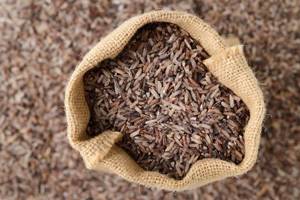
Rice is a valuable grain that should be present in the human diet. Being nourishing and healthy, it will benefit the body. The main thing is to observe moderation and not overeat, then it will help get rid of extra pounds and will not cause harm, because the calorie content of boiled rice per 100 grams is no more than 140 kcal. Regular consumption of cereal, due to its absorbent properties, will cleanse the body of waste and toxins and start the metabolism.
Rice has become so firmly established in the modern diet that its exclusion from the menu seems incredible. Useful properties, rich mineral composition and pleasant taste - all this allows everyone to find their favorite variety and prepare a certain dish: sushi, risotto, porridge. Cereals are available to everyone.
Preparation
If you want to cook fluffy rice, you need to rinse it under cold water before cooking. This way you will get rid of starch, which is responsible for stickiness. Rinse the rice about five times or more until the water runs clear. It is most convenient to perform this procedure using a fine sieve.
ruchiskitchen.com
Some dishes, such as risotto, require sticky rice. In this case, there is no need to rinse it. As a last resort, you can limit yourself to one rinse to wash away all excess.
To make rice cook faster, you can soak it for 30–60 minutes. Then the cooking time will be reduced by almost half. However, in this case it is better to reduce the amount of water used for cooking.



